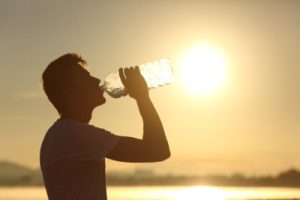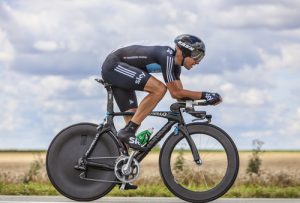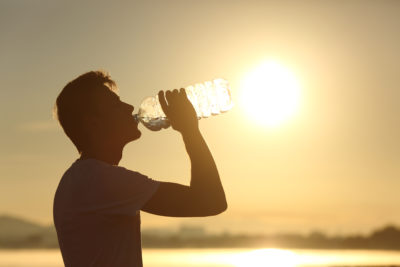Right, it looks like summer is finally here (immediately crosses fingers), but with the right nutrition and clothing strategies, that shouldn’t stop you cycling and running…
Training and racing in the heat can be a nightmare as your body wrestles not only with the environment but also the metabolic cost of cycling, running or triathlon.
You’ll not be surprised to learn that many of the issues surrounding exercising in the heat stem from dehydration. When you’re dehydrated, your blood thickens, causing the heart has to work harder. Your ability to process glucose and create energy is reduced because energy production requires water, and because blood is channeled to the surface to cool the body, this can reduce the amount of blood – and oxygen – to your leg muscles.
Drink more water

An American study showed that a sustained state of dehydration impaired strength, power and high-intensity muscular endurance by 2%, 3% and 10%, respectively. Those are significant figures, especially that 10% drop in muscular endurance.
But what level of dehydration begins to affect core temperature and impede performance? Historically, 2% was deemed as the tipping point, but recent research from Brock University scientist and cyclist Stephen Cheung suggests this figure isn’t set in stone, with 3% the suggested level.
Either way, a well-designed hydration plan is a must. Measuring your sweat rate is a simple way to gauge this. Run or cycle for 60mins, ideally in the conditions you’ll face in the summer, and drink nothing from start to finish.
You should weigh yourself before and after and see how much weight you’ve lost. Around 1kg fluid loss should be replaced with one litre of fluid. This should include electrolytes lost in sweat, especially sodium, which helps with transferring water from the bloodstream to the working cells.
Get fit. Stay cool
You should also get fitter to maintain a safe core. As your fitness grows, you experience a host of adaptations that are naturally conducive to exercising fast in the heat.
These include an improved sweat response allowing your body to dissipate heat quickly. This means that you start sweating at a lower core temperature and your body’s sweating response to an increase in core temperature is more sensitive.
Other ways to keep cool

Wear light clothing – in weight and colour – to help to deflect the sun’s rays. You could go all Team Sky and purchase a top with ColdBlack technology, which means darker materials can still fend off sunlight.
You have a huge amount of thermoreceptors in your extremities, like your hands and feet. Trek Segafredo is one team who use wristbands with frozen spray applied.
You should also avoid exercising in the hottest part of the day, unless you really have to. Exercise in the mornings or evenings when the heat is less intense.
Finally, a quality suncream that’s water-resistant with an SPF of at least 30 is a must. Pay particular attention to your neck. Do the same to your bonce if your hairstyle resembles that of Greg Wallace.
Blog post written by James Witts. James is a writer and editor specialising in endurance sport, health & fitness, outdoor adventure and sports science.











